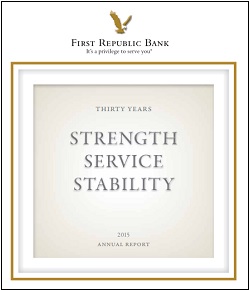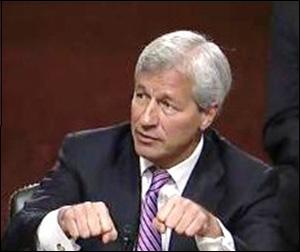By Pam Martens and Russ Martens: May 1, 2023 ~
 On Wall Street, the business model is you eat what you kill. Jamie Dimon and the bank he helms, JPMorgan Chase, just devoured First Republic Bank after Dimon had orchestrated the worst “rescue” of First Republic in the history of banking rescues. Given the outcome, one has to wonder if this rescue flop was a bug or a feature. (See Related Articles below.)
On Wall Street, the business model is you eat what you kill. Jamie Dimon and the bank he helms, JPMorgan Chase, just devoured First Republic Bank after Dimon had orchestrated the worst “rescue” of First Republic in the history of banking rescues. Given the outcome, one has to wonder if this rescue flop was a bug or a feature. (See Related Articles below.)
After 7 weeks of Jamie Dimon’s “rescue,” First Republic and its preferred shares had been downgraded by credit rating agencies to junk; its common stock had lost 98 percent of its market value, closing at $3.51 on Friday and at $1.90 in pre-market trading early this morning; its long-term bonds were trading at 43 cents on the dollar; and depositors continued to flee the bank.
And in order to pay out all those deposits that were taking flight, First Republic had to take out expensive loans from the Fed, the Federal Home Loan Bank of San Francisco, and a credit line from JPMorgan Chase, jeopardizing its future profitability. The interest cost of those loans significantly exceeded, in many cases, the rates it had locked in on the jumbo residential mortgages it had made to its wealthy clients and the government-backed bonds it had purchased during years of low interest rates on Treasury securities.
JPMorgan Chase’s statement on the takeover of First Republic this morning indicated that it “is not assuming First Republic’s corporate debt or preferred stock” and the “FDIC will provide loss share agreements covering acquired single-family residential mortgage loans and commercial loans, as well as $50 billion of five-year, fixed-rate term financing.”
Dimon’s so-called rescue plan, announced on March 16, made no sense from the beginning. It consisted of 11 banks chipping in a total of $30 billion to place into First Republic Bank as uninsured deposits for 120 days. Four banks contributed two-thirds of the total deposits with JPMorgan Chase, Bank of America, Citigroup and Wells Fargo sluicing $5 billion each. Morgan Stanley and Goldman Sachs deposited $2.5 billion each; while BNY Mellon, State Street, PNC Bank, Truist and U.S. Bank each deposited $1 billion.
But at the time of this display of heroics, First Republic Bank was bleeding deposits because it already had too many uninsured deposits – those above the FDIC cap of $250,000. And its losses on underwater mortgages and low-yielding bonds were making headlines every day. What it needed was an injection of long-term capital, not an injection of more uninsured deposits with a short-term horizon.
To keep the pitchforks at bay from the other 10 banks that chipped in to the $30 billion rescue fund of uninsured deposits, JPMorgan Chase said in its statement that it will be repaying the 10 banks for the deposits they each contributed.
What is raising eyebrows across Wall Street and throughout the Biden administration this morning, is that JPMorgan Chase is already ranked by its regulators as the riskiest bank in the U.S. (See Federal Data Show JPMorgan Chase Is, By Far, the Riskiest Bank in the U.S.) Making it bigger simply makes it more systemically riskier.
JPMorgan Chase’s history of gobbling up competitors is both stunning and an indictment of federal banking regulators. In 1955, Chase National Bank merged with The Bank of the Manhattan Company to form Chase Manhattan Bank. In 1991, Chemical Bank and Manufacturers Hanover announced their merger. Both banks had been severely weakened – Chemical from bad real estate loans and Manufacturers from bad loans to developing nations. In 1995, Chemical Bank merged with Chase Manhattan Bank. In 2000, JPMorgan merged with Chase Manhattan Corporation. In 2004, JPMorgan Chase merged with Bank One. In 2008, during the height of the financial crisis, JPMorgan Chase was allowed to buy Washington Mutual. These are just the largest bank consolidations. Over the years, Chase acquired dozens of smaller banks.
At the time of JPMorgan Chase’s purchase of Washington Mutual in 2008 – WaMu was the largest bank failure in U.S. history. JPMorgan Chase is now being allowed to purchase First Republic Bank, the second largest bank failure in U.S. history.
This flies in the face of President Biden’s Executive Order of July 9 2021, where he promised that his administration would “guard against excessive market power” and enforce antitrust laws. With regard to banks, the President wrote:
“To ensure Americans have choices among financial institutions and to guard against excessive market power, the Attorney General, in consultation with the Chairman of the Board of Governors of the Federal Reserve System, the Chairperson of the Board of Directors of the Federal Deposit Insurance Corporation, and the Comptroller of the Currency, is encouraged to review current practices and adopt a plan, not later than 180 days after the date of this order, for the revitalization of merger oversight under the Bank Merger Act and the Bank Holding Company Act of 1956 (Public Law 84-511, 70 Stat. 133, 12 U.S.C. 1841 et seq.) that is in accordance with the factors enumerated in 12 U.S.C. 1828(c) and 1842(c).”
See In 16 Years, the Fed Has Approved 4,506 Bank Mergers and Denied One.
The Bank Holding Company Act, a federal law, prohibits banks that control “more than 10 percent of the total amount of deposits of insured depository institutions in the United States” to purchase another bank.
According to its call report to federal regulators, as of December 31, 2022, JPMorgan Chase held $2.01 trillion in deposits in domestic offices and $426 billion in deposits in foreign offices, for a total of $2.4 trillion. According to the FDIC, as of December 31, 2022, there was a total of $17.7 trillion in domestic deposits in all U.S. banks and savings associations. That means that JPMorgan Chase held 11.36 percent of total U.S. domestic deposits, well in excess of the 10 percent cap, and should have been ineligible to buy yet another bank and become even more systemically dangerous.
But some smart Wall Street lawyer or lobbyist had the clever foresight to stick into the legislation that the market share cap could be waived if the acquisition involved one or more banks in default or in danger of default.
This caveat makes about as much sense as Jamie Dimon’s “rescue” plan. Just what the United States does not need in the time of a banking crisis, when one or more banks are defaulting, is to put in place a more systemic future banking crisis by consolidating big banks.
In addition, under the tenure of Jamie Dimon as Chairman and CEO of JPMorgan Chase, the bank has racked up an unprecedented five felony counts and a rap sheet that is likely the envy of the Gambino crime family. And yet, mainstream media continues to hold Dimon up as the wise and prudent wizard of Wall Street. (See Jamie Dimon Tells 60 Minutes He’s a Patriot; There’s Good Reason to Think He’s a Crime Boss; and JPMorgan’s Board Made Jamie Dimon a Billionaire as the Bank Rigged Markets, Laundered Money, and Admitted to Five Felony Counts.)
Related Articles:
Ahead of First Republic Bank’s Earnings Report Today, Moody’s Paints a Bleak Outlook
First Republic Bank: Dark Pool Trading by “Rescuers” Exploded in Volume as FRC Tanked
First Republic: Meet the Bank at the Center of the Michael Cohen Scandal


